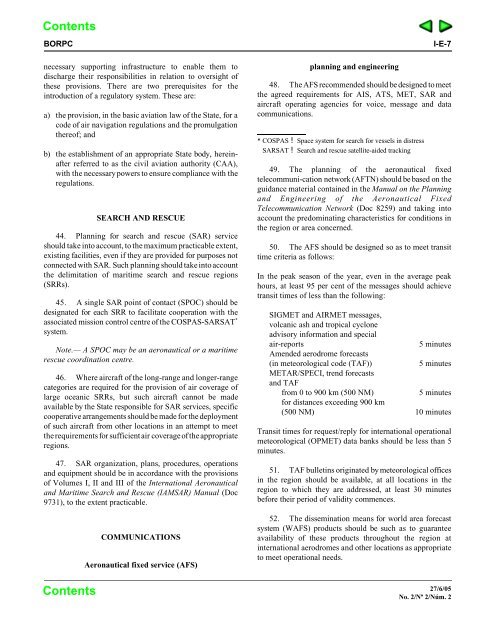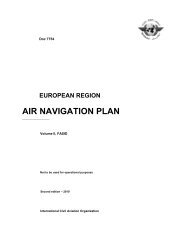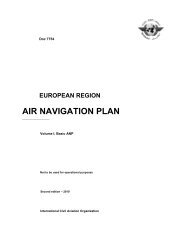introduction - ICAO Public Maps
introduction - ICAO Public Maps
introduction - ICAO Public Maps
Create successful ePaper yourself
Turn your PDF publications into a flip-book with our unique Google optimized e-Paper software.
BORPC<br />
necessary supporting infrastructure to enable them to<br />
discharge their responsibilities in relation to oversight of<br />
these provisions. There are two prerequisites for the<br />
<strong>introduction</strong> of a regulatory system. These are:<br />
a) the provision, in the basic aviation law of the State, for a<br />
code of air navigation regulations and the promulgation<br />
thereof; and<br />
b) the establishment of an appropriate State body, hereinafter<br />
referred to as the civil aviation authority (CAA),<br />
with the necessary powers to ensure compliance with the<br />
regulations.<br />
SEARCH AND RESCUE<br />
44. Planning for search and rescue (SAR) service<br />
should take into account, to the maximum practicable extent,<br />
existing facilities, even if they are provided for purposes not<br />
connected with SAR. Such planning should take into account<br />
the delimitation of maritime search and rescue regions<br />
(SRRs).<br />
45. A single SAR point of contact (SPOC) should be<br />
designated for each SRR to facilitate cooperation with the<br />
associated mission control centre of the COSPAS-SARSAT *<br />
system.<br />
Note.— A SPOC may be an aeronautical or a maritime<br />
rescue coordination centre.<br />
46. Where aircraft of the long-range and longer-range<br />
categories are required for the provision of air coverage of<br />
large oceanic SRRs, but such aircraft cannot be made<br />
available by the State responsible for SAR services, specific<br />
cooperative arrangements should be made for the deployment<br />
of such aircraft from other locations in an attempt to meet<br />
the requirements for sufficient air coverage of the appropriate<br />
regions.<br />
47. SAR organization, plans, procedures, operations<br />
and equipment should be in accordance with the provisions<br />
of Volumes I, II and III of the International Aeronautical<br />
and Maritime Search and Rescue (IAMSAR) Manual (Doc<br />
9731), to the extent practicable.<br />
COMMUNICATIONS<br />
Aeronautical fixed service (AFS)<br />
planning and engineering<br />
I-E-7<br />
48. The AFS recommended should be designed to meet<br />
the agreed requirements for AIS, ATS, MET, SAR and<br />
aircraft operating agencies for voice, message and data<br />
communications.<br />
* COSPAS ! Space system for search for vessels in distress<br />
* SARSAT ! Search and rescue satellite-aided tracking<br />
49. The planning of the aeronautical fixed<br />
telecommuni-cation network (AFTN) should be based on the<br />
guidance material contained in the Manual on the Planning<br />
and Engineering of the Aeronautical Fixed<br />
Telecommunication Network (Doc 8259) and taking into<br />
account the predominating characteristics for conditions in<br />
the region or area concerned.<br />
50. The AFS should be designed so as to meet transit<br />
time criteria as follows:<br />
In the peak season of the year, even in the average peak<br />
hours, at least 95 per cent of the messages should achieve<br />
transit times of less than the following:<br />
SIGMET and AIRMET messages,<br />
volcanic ash and tropical cyclone<br />
advisory information and special<br />
air-reports<br />
5 minutes<br />
Amended aerodrome forecasts<br />
(in meteorological code (TAF))<br />
5 minutes<br />
METAR/SPECI, trend forecasts<br />
and TAF<br />
from 0 to 900 km (500 NM)<br />
5 minutes<br />
for distances exceeding 900 km<br />
(500 NM) 10 minutes<br />
Transit times for request/reply for international operational<br />
meteorological (OPMET) data banks should be less than 5<br />
minutes.<br />
51. TAF bulletins originated by meteorological offices<br />
in the region should be available, at all locations in the<br />
region to which they are addressed, at least 30 minutes<br />
before their period of validity commences.<br />
52. The dissemination means for world area forecast<br />
system (WAFS) products should be such as to guarantee<br />
availability of these products throughout the region at<br />
international aerodromes and other locations as appropriate<br />
to meet operational needs.<br />
27/6/05<br />
No. 2/Nº 2/Núm. 2














